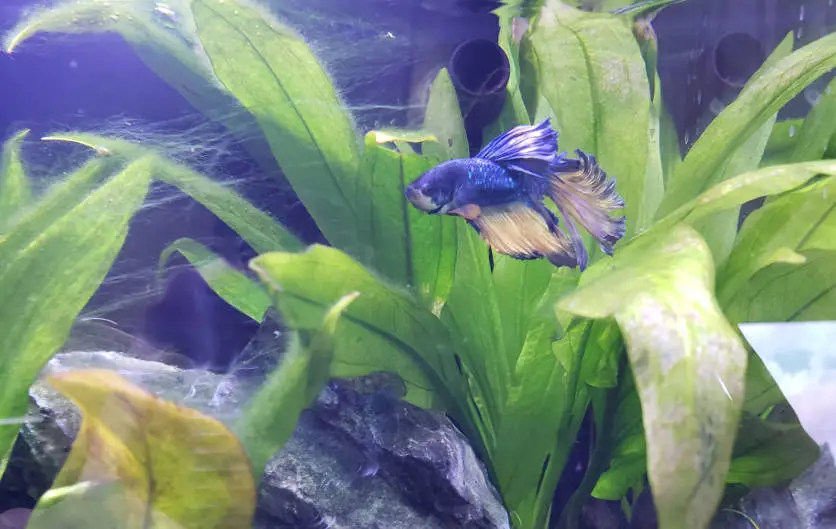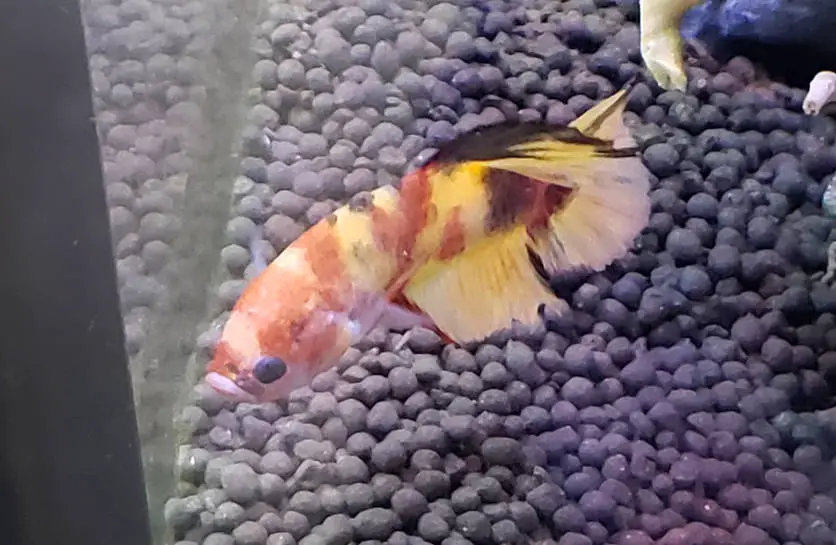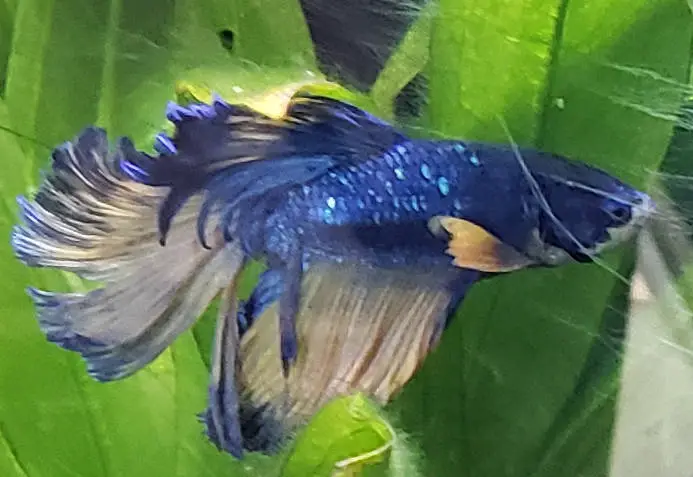
| Do | Do Not |
|---|---|
| Use an aquarium no smaller than 2.5 gallons | Keep your betta in a small bowl. Small bowls are not acceptable aquariums. |
| Keep the temperature between 78-80F | Fluctuate the temperature or keep the water too hot/cold |
| Use low flow or external filters to maintain water conditions | Use a powerful filter. Even small internal filters can produce strong flows |
| Pair with peaceful tank mates | Pair with fin nippers, colorful fish or fish with long, flowing fins |
| Feed a mixture of three pellets or bloodworms a day | Overfeed / feed until they no longer eat |
| Keep plenty of tall plants for hiding spots | Use sharp plastic plants that can tear fins |
well known for its beautiful flowing fins and an aggressive temper, The Betta fish will often be the centerpiece of their tanks. When establishing an environment for them there are several things you need to keep in mind:
- Water Temperature
- Tank Size
- Feeding
- Filtration
- Lighting
- Tank Mates
By mastering each point we can create the perfect environment to care for our betta fish.
Origin Of The Betta Fish
The betta fish we know today, also known as the Siamese fighting fish, has been bred over the years to have longer fins and a more aggressive temperament. This began over 150 years ago in Thailand. They can be found in rice paddy fields, water canals, flood plains and shallow streams in Laos, Thailand and their neighboring countries. Note how all of these are large bodies of water, often with little to no movement. These fact are key to how we pick out our tank, as they do not live in small dirty ponds as many believe. Additionally the temperatures of these waters are considered tropical, making the temperature higher than many freshwater fish want. Finally we should take note that they originate from heavily planted areas. Combine all this knowledge and you’ll have the perfect betta fish tank.
Water Temperature
Caring for a betta fish includes keeping the right temperature, which would be between 78 and 80 degrees Fahrenheit. As aquariums are often a few degrees cooler than the surrounding temperature, it is impossible to forgo a heater and maintain the perfect temperature. However special care must be taken when selecting the right heater, as a heater too large for the tank can cause many health issues. Large heaters can easily over heat a tank, as they do not immediately cool off when the water hits the right temperature. This supports the idea of a larger tank to help keep betta fish stress free and safe.
Diet
As easy as generic fish flakes are, they are far from ideal. In the wild they will often sit near the surface and catch bugs. This contradicts the belief that betta fish can survive off of plant roots and suggests a more carnivorous diet. A mixture of pellets and blood worms are the most recommended choices. If you have a picky betta you can entice them into eating with brine shrimp. Do not use these often as they offer little nutrition.

Additionally special notice must be taken of their mouth. Betta fish naturally have an upwards facing mouth which enabled them to take air and eat from the surface. This also means they have more trouble eating food that has begun to sink. Avoid sinking pellets or pushing the food into the tank and let the betta fish notice their food on the surface.
Next on this list is the amount of feeding. Betta fish only have a stomach about as big as their eye. Sure they will eat much more than that, any animal will. Turning down food in the wild and risking starvation is nearly suicidal. However in our enclosed tanks they do not need to worry and should not be fed until they stop eating. Instead only feed exactly enough for all the fish in your aquarium. For betta fish this means two pellets or three blood worms a day. While this may seem like very little food keep in mind neon tetras only need a single flake per day to flourish. Additionally bloodworms do not provide as much nutrition as pellets, making variation essential.
Note: When using frozen foods such as bloodworms be sure to rinse the food off with de-chlorinated water or tank water before feeding. Frozen foods will have many excess nutrients coating on the outside. This disperses before your fish eats the food and contaminates the water. It will in turn either raise ammonia levels or help start algae blooms. The water you use to rinse the food must be de-chlorinated. You can use a bit of the tanks own water as long as you don’t add it back to the tank.
Betta Fish Water Needs
Betta fish possess a labyrinth bladder that they use to breath from the waters surface. This is what allows them to live in tiny bodies of still water with no aeration. Be sure to leave open space at the top of the tank. That being said you should still aerate their water.
On the other hand this does not mean to remove the hood from the top of your tank. Betta fish are excellent swimmers and can jump frequently. Removing the lid almost ensures eventual death by escape.
Remember these fish are used to very still waters and cannot compete with virtually any flow. Even the water movement created by internal filters can be too great for a betta fish. For the perfect environment this can be solved by using a larger tank and placing the filter at one end of the tank. The output may be too strong but they will learn to swim in the other parts of the tank.
You will easily be able to tell if the flow is too strong in your tank, as they will be spun around and have extreme difficulty swimming in a current. Turn off anything creating flow right away if you notice this. You can always turn things back on later when you fix the flow issue but the betta can suffer serious damage if left in quick moving water for even a few minutes.

Tank Mates
When picking a tank mate there is more to it than what a betta fish wont fight with. However that is one of the biggest factors so we will cover it first.
Male betta fish are extremely aggressive towards each other and will fight. This has been bred into the fish and is not a trait you can get around. If the tank is small enough, even female betta fish can be aggressive towards one another.
Tankmates that are attacked often have at least one of these two traits. Long fins and/or bright colors. Any colorful fish who possess long fins is in danger and therefore not a suitable tankmate. This is not one sided. Aggressive fish who are frequent fin nippers can actually wear down a betta fish and kill them. In short avoid both colorful, long fin fish as well as fin nipping aggressive fish.
Finally male and female betta fish are able to co-exist with one another, they wouldn’t still exist if they couldn’t. However if they end up breeding the two fish should be separated as soon as possible. Once the female lays her eggs the male will become extremely protective of the eggs. He will attack anyone, including the female, if they come near the eggs. Because of this you should not plan on keeping both genders together for extended periods of time.
Lighting
Betta fish do not require powerful lights and will be fine with the most basic lights. Instead you need to think about your tank as a whole. This means picking out your light based on what you want the tank to look like and what kind of plants you will be keeping.
For tanks without plants you will only need a light to see. These are generally cheaper to own.
Tanks that will be housing plants should get stronger lights that can provide nourishment. Look for higher wattage lights or LED lights made to grow plants. LED lights are the best choice as they last longer and do not generate much heat.
Tank And Decoration
As stated in the table betta fish cannot be kept in tiny bowls. In fact they do best in tanks that are 20 gallons in size. The absolute minimum they need to be happy is 2.5 gallons which far exceeds a fish bowls capacity. There are many betta fish tanks that are custom made for perfect small environments. Additionally rounded tanks disorient the fish, causing them to frequently hit the glass and stress themselves out. Not to mention round bowls will have the same footprint as significantly bigger square tanks.
For the decoration I highly recommend using live plants. They give the fish plenty of cover to make them feel safe. They also do not harm the fish if they bump into them. The same cannot be said for most plastic plants, as the edges can frequently scrape scales and spear fins. With how beneficial live plants are I highly advise against the use of plastic plants. Other decor is acceptable as long as you avoid sharp edges.
Betta fish often face upwards, meaning they will not notice the gravel or sand bed too much. This allows you to use any color you want without fear of reflective gravel that can upset other fish. If you pair the betta fish with other fish be sure they are not startled by unusual substrate before adding any to the tank.